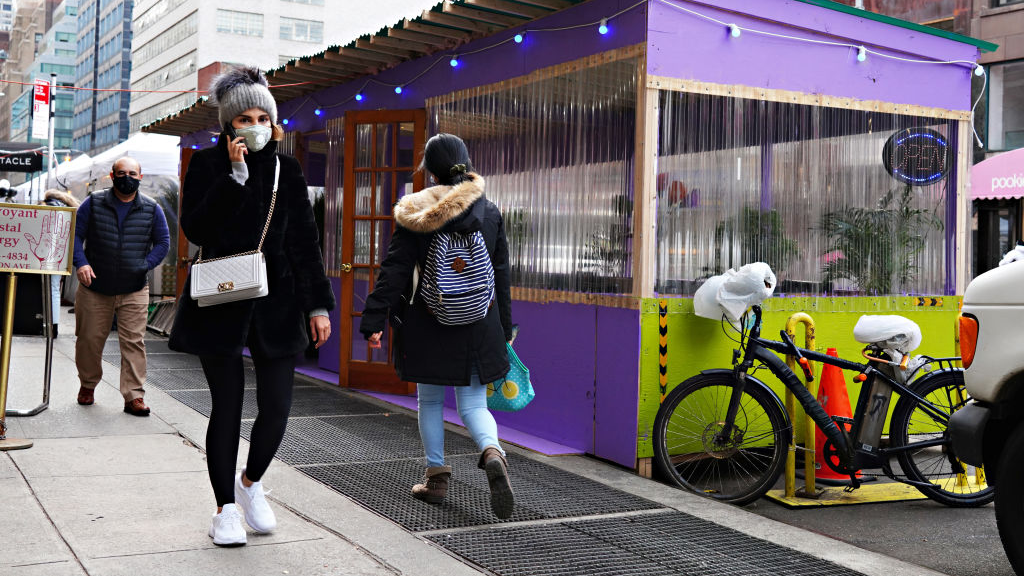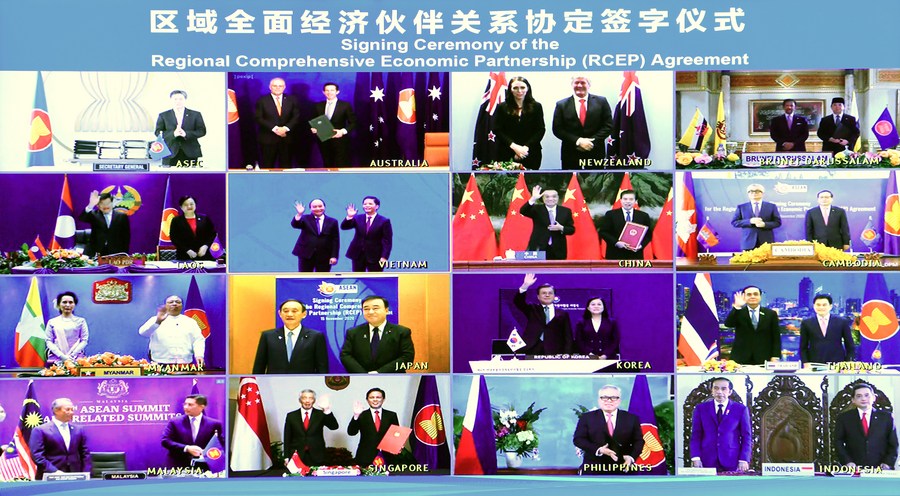
People wearing protective masks walk by a weatherized outdoor dining structure outside a restaurant on the Upper East Side in New York as the city continues the reopening efforts following restrictions imposed to slow the spread of coronavirus, November 19, 2020. /Getty
People wearing protective masks walk by a weatherized outdoor dining structure outside a restaurant on the Upper East Side in New York as the city continues the reopening efforts following restrictions imposed to slow the spread of coronavirus, November 19, 2020. /Getty
Editor's note: Harvey Dzodin is a senior fellow at the Center for China and Globalization. The article reflects the author's opinions, and not necessarily the views of CGTN.
For many of us, 2020 has been the strangest year of our lives, given the shock caused by COVID-19. I'm reminded of the memorable opening of Charles Dickens's great novel, The Tale of Two Cities: "It was the best of times, it was the worst of times, it was the age of wisdom, it was the age of foolishness." November perfectly illustrates the contradictions.
This month, in much of the world, one or more successive waves of the coronavirus continue to wreak havoc. People are dying and economies are comatose. Yet, in China and a few smaller countries, personal lives and economic activities have returned to near normalcy. With the imminent promise of effective vaccines, all countries have the prospect of being part of a community of a shared healthy future for mankind in 2021.
At the same time, however that many countries are floundering and/or have given up on confronting the virus, others have bound themselves together in the Regional Comprehensive Economic Partnership (RCEP), reorienting the global compass needle from West to East in what is now not only the Chinese Century, but the Asian Century. This is a genuine pivot, a game-changer and a sign of things to come.
As an American, I've always looked forward to November, but not this year. I'm under a second COVID-19 lockdown in Vienna. The charms of the city like the Golden Hall and Empress Sisi's Hofburg Palace are off-limits to all. Tourism is nonexistent and so the revenue that helps power Austria's economy. Having failed to arrest the virus like China has, the government here has the near-impossible task of finding the microscopic sweet spot balancing the public's health and that of its economy. Virtually all of Europe, Latin America and beyond are in the same boat.
Back in the U.S., we celebrate Thanksgiving Day on the fourth Thursday in November. It's the most family-oriented holiday of the year and usually the most traveled, although a pale truncated version of China's Spring Festival. But this year it's difficult to be truly thankful, even given the promise of numerous vaccines from the U.S., China, the World Health Organization (WHO)'s COVAX accelerator and elsewhere.
The fact is that after more than a quarter of a million deaths and almost 12 million cases, many avoidable, U.S. numbers are dramatically accelerating, not abating. The current administration continues to fail to address this calamity. The deeply divided country doesn't even have an officially declared winner of the November 3 presidential election.
China seems like it's in another galaxy; life there is so normal. China has virtually no COVID-19 cases, and those that exist, virtually all foreign in origin, are dealt with speed and efficiency to prevent further spread. No place but China has the ability to competently test the population of a city of nine million people in a mere five days as was done in Qingdao last month.
As a consequence, China's economy has largely recovered and is robust. In fact, despite COVID-19, China's first centennial goal of building a moderately prosperous socialist society in all respects is on track to being accomplished by year-end as is its second centennial goal of becoming a great modern socialist country by 2049.

Chinese Premier Li Keqiang and leaders of other countries attend the signing ceremony of the Regional Comprehensive Economic Partnership (RCEP) agreement after the fourth RCEP Summit, which is held via video link, November 15, 2020. /Xinhua
Chinese Premier Li Keqiang and leaders of other countries attend the signing ceremony of the Regional Comprehensive Economic Partnership (RCEP) agreement after the fourth RCEP Summit, which is held via video link, November 15, 2020. /Xinhua
With the prospect of the country's implementation of China's 14th Five-Year Plan in tandem with the dual circulation paradigm, under the leadership of President Xi Jinping and the Communist Party of China, the country appears to be the only major economy poised for growth this year. Even in this most troubled time, China's future promises to be bright.
Despite the global gloom, even when tempered by the prospect of global normalcy by this time next year, the virtual RCEP signing ceremony was definitely a transformative milestone. It's one of those rare events that demarcate one era from another. As Chinese Premier Li Keqiang said: "Under the current global circumstances, the fact the RCEP has been signed after eight years of negotiations brings a ray of light and hope amid the clouds." He said RCEP also represented "a victory of multilateralism and free trade."
RCEP's 15 Asia-Pacific countries encompass some 2.2 billion people and 30 percent of the world's economic output. It is bigger than both the region of the U.S.-Mexico-Canada Agreement and the European Union.
RCEP is the first multilateral trade deal for China, the first bilateral tariff reduction arrangement between Japan and China, and the first time China, Japan and South Korea have joined in a single free-trade agreement.
Although some experts downplay its significance, I believe RCEP is nothing short of a game-changer. RCEP is expected to eliminate a range of tariffs on imports within 20 years. The 500+ page agreement includes provisions on intellectual property, telecommunications, financial services, e-commerce and professional services.
Never mind that it will make trading for members significantly easier, it will also mean nonmember countries and their enterprises will be economically disadvantaged. For the U.S., being on the outside means it loses considerable influence and the ability to shape trade in the Asia-Pacific region and beyond. The U.S. Chamber of Commerce, representing large American business interests, said on Monday that its members were concerned that the U.S. is being left behind as economic integration accelerates across the Asia-Pacific region.
Similar to the economic integration of the European Union begun under its predecessors like the European Coal and Steel Community and the European Economic Community, RCEP is expected to improve relations among its member states by creating economic interdependence as companies invest in each other's countries. It could also add $209 billion annually to world incomes and $500 billion to world trade by 2030.
RCEP also has serious implications for integrating its member states into China's Belt & Road Initiative (BRI). Of particular import, as the coronavirus rages on, will be an emphasis on a Health Silk Road, particularly in Southeast Asia, to prevent supply shortages as were seen earlier this year, as well as to promote high-tech in the public health arena.
(If you want to contribute and have specific expertise, please contact us at opinions@cgtn.com.)

